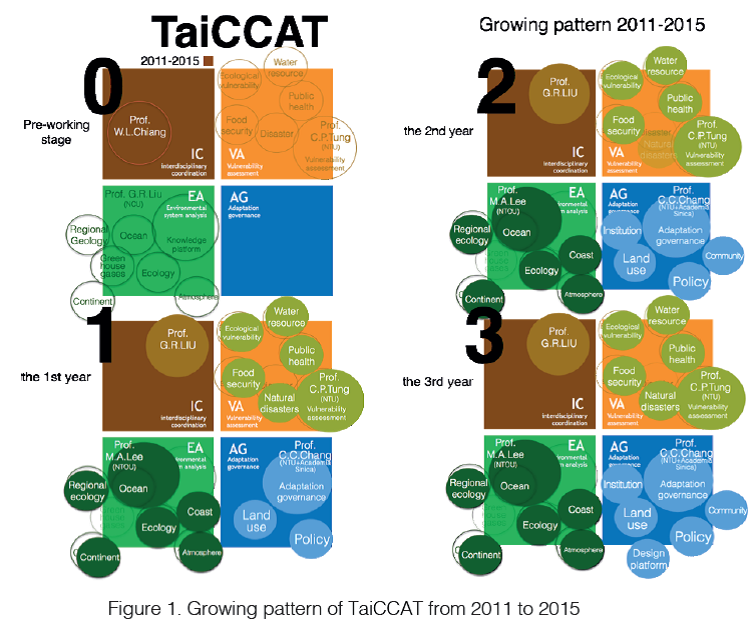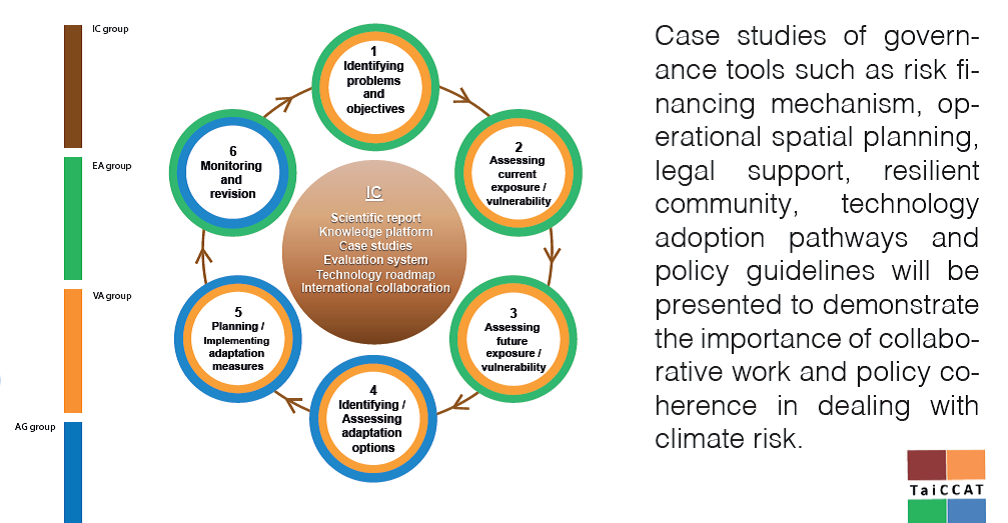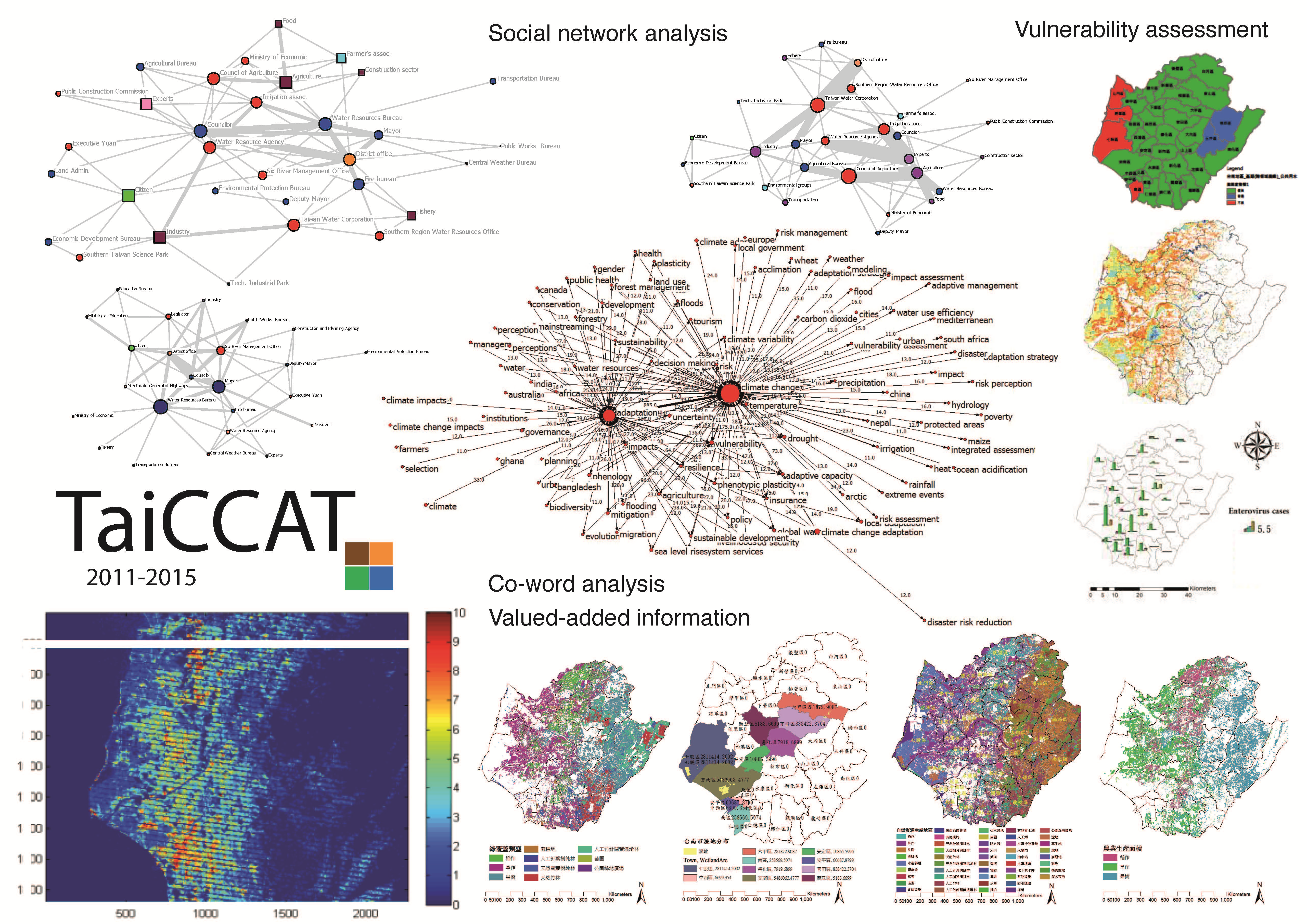The concentration of people, infrastructure and ecosystem services make Taiwan prime sites for climate change adaptation. Promoting adaptation, however, is not only a technical obligation but also a social and political challenge that relies new studies to support. The Taiwan Integrated Research Programme on Climate Change Adaptation Technology (TaiCCAT) was formed in 2011 to develop knowledge for decision-making services in adaptation. Following the interdisciplinary approach, three working groups were established and highly recommended to collaboration and communication. The research outcomes could be divided in three major parts: first, to present the extremity of climate change in Taiwan; second, to develop pathways and supporting tools in practical fields; and third, to examine the capacity of decision-making in promoting climate adaptation. All of them are closely linked to the ways of local governance and implementation.
TaiCCAT includes a head office for interdisciplinary coordination and three working groups for environmental system analysis (EA), vulnerability assessment (VA) and adaptation governance (AG). The participating scholars are widely diverse. In 2015, twenty-two scholars from eight universities and research institutes were involved in TaiCCAT to contribute knowledge for climate adaptation. Numbers of the sub-projects and responsible coordinators can vary according to the standard expectations. For example, numbers of the sub-projects for adaptation governance increased from three in 2012 to six in 2015 due to a realization of the urgent needs for adaptation studies in the fields of social science (Figure 1).

The coordinative framework include a head office and three working groups. • WG1: environmental system analysis (the EA group) The EA group works for producing useful environmental indices, the environmental potential and other value-added products and services in environmental system based on traditional/untraditional data and satellite observation. Its major task is set up to reflect the consideration of the changing climate – according to the IPCC report, the intensity and frequency of climate extremes is likely to increase in the 21st century over many areas of the globe. This will widely influence on the environment and the human societies. The EA group aims to develop applicable measures for analysing potential impact of climate change on the environment, not only to understand the regional climate change tendency but also to provide recommendations for risk reduction. Data collection and analysis mainly relies on the geographic information system. The study uses Tainan city-region for empirical studies. The value-added products are developed on the basis of four geospatial characteristics: urban areas, rural areas, mountainous areas and coastal areas. These products are expected to be used in vulnerability assessment and to support decision-making for adaptation governance. WG2: vulnerability assessment (the VA group) Framing cross-sectoral collaboration for vulnerability assessment is the major focus of the VA group. This requires cross-sectoral risk assessment and a development of climate change adaptation supportive tools. The VA group explores cross-sectoral risk assessment in five selected fields: environmental disasters, public health, food security, ecosystems and water resources. These fields are considered to be extremely vulnerable to climate change in the Taiwanese context. In addition to the practical study, the VA group also contributes to develop three assessment tools. The climate adaptation supportive tool (CAST) was developed at the early stage of the research programme to coordinate and to guide decision-making for adaptation. Following the CAST, the AdapCAB provided applicable check tips self-assessment and examination. The Data information knowledge wisdom (DIKW processes) was initiated as assessment guidance. The Cross-sectoral system dynamics model (CSD model) could be used to support collaborative studies in multiple fields, and the AdapCAB provided an opportunity for self-assessment in decision-making.
WG3: adaptation governance (the AG group) Adaptive governance help to address the impact on society, institution, economy, and ecology which are the foundations in building resilience against the vast challenges posed by climate change. Currently, climate resilience efforts encompass risk management, adaptation pathway, spatial adaption, community adaption, public and private partnerships that are being implemented at all scales of society. Effective governance (not necessarily excluded in the government) has therefore become a priority in climate change adaption. The purpose of the AG group is to introduce science-based climate risk management systems that contain the uncertain aspect of climate change and to explain how to use community- based indicators to evaluate the adaptation potentials in different spatial level. It also discusses how to identify and narrow the gap of understanding between the public and private sectors and increase stakeholders’ capabilities in climate adaptations. It is essential that protocols and procedures that are in place that facilitate management of climate risk through implementation of climate change adaptation strategies.

Collaboration among the working groups was guided by the CAST framework and by the empirical studies in the selected area, Tainan city-region. The CAST was developed according to brainstorming and reviewing literature of previous studies (Burton et al., 2002, Lim and Spanger-Siegfried, 2004, IPCC, 2007). It includes six steps: (i) identifying problems and ass establishing objectives, (ii) assessing and analysing current risk, (iii) assessing and analysing future risk, (iv) identifying and assessing adaptation options, (v) planning and implementing adaptation pathway, and (vi) monitoring and modifying adaptation pathway. The six steps run in circle (see Figure 3). By following the 6 steps, decision-making can gain information concerning the misleading gaps of the existing frameworks as well as the strategies for climate change adaptation. The CAST is encouraged to apply in order. However, it is also possible for users to start the round map in a specific step, not necessarily to be the first step, and complete the tour of decision-making for climate change adaptation.



